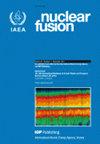Tokamak edge-SOL turbulence in H-mode conditions simulated with a global, electromagnetic, transcollisional drift-fluid model
IF 4
1区 物理与天体物理
Q1 PHYSICS, FLUIDS & PLASMAS
引用次数: 0
Abstract
The design of commercially feasible magnetic confinement fusion reactors strongly relies on the reduced turbulent transport in the plasma edge during operation in the high confinement mode (H-mode). We present first global turbulence simulations of the ASDEX Upgrade tokamak edge and scrape-off layer in ITER baseline H-mode conditions. Reasonable agreement with the experiment is obtained for outboard mid-plane measurements of plasma density, electron and ion temperature, as well as the radial electric field. The radial heat transport is underpredicted by roughly 1/3. These results were obtained with the GRILLIX code implementing a transcollisional, electromagnetic, global drift-fluid plasma model, coupled to diffusive neutrals. The transcollisional extensions include neoclassical corrections for the ion viscosity, as well as either a Landau-fluid or free-streaming limited model for the parallel heat conduction. Electromagnetic fluctuations are found to play a critical role in H-mode conditions. We investigate the structure of the significant E × B flow shear, finding both neoclassical components as well as zonal flows. But unlike in L-mode, geodesic acoustic modes are not observed. The turbulence mode structure is mostly that of drift-Alfvén waves. However, in the upper part of the pedestal, it is very weak and overshadowed by neoclassical transport. At the pedestal foot, on the other hand, we find instead the (electromagnetic) kinetic ballooning mode, most clearly just inside the separatrix. Our results pave the way towards predictive simulations of fusion reactors.用全局电磁跨碰撞漂移流体模型模拟的托卡马克边缘-SOL H模条件下的湍流
商业上可行的磁约束聚变反应堆的设计在很大程度上依赖于高约束模式(H 模式)运行期间等离子体边缘湍流传输的减少。我们首次提出了在热核实验堆基线 H 模式条件下 ASDEX 升级版托卡马克边缘和刮离层的全局湍流模拟。等离子体密度、电子和离子温度以及径向电场的外侧中平面测量结果与实验结果基本一致。径向热传输的预测值低了大约 1/3。这些结果是通过 GRILLIX 代码获得的,该代码采用了跨碰撞、电磁、全局漂移-流体等离子体模型,并与扩散中性耦合。跨碰撞扩展包括离子粘度的新古典修正,以及平行热传导的朗道流体或自由流有限模型。我们发现电磁波动在 H 模式条件下起着关键作用。我们研究了重要的 E × B 流切变的结构,发现了新古典成分和带状流。但与 L 模式不同的是,没有观测到大地声模式。湍流模式结构主要是漂移-阿尔芬波。然而,在基座的上部,湍流非常微弱,被新古典传输所掩盖。另一方面,在基座底部,我们发现了(电磁)动气球模式,在分离矩阵内部最为明显。我们的研究结果为聚变反应堆的预测模拟铺平了道路。
本文章由计算机程序翻译,如有差异,请以英文原文为准。
求助全文
约1分钟内获得全文
求助全文
来源期刊

Nuclear Fusion
物理-物理:核物理
CiteScore
6.30
自引率
39.40%
发文量
411
审稿时长
2.6 months
期刊介绍:
Nuclear Fusion publishes articles making significant advances to the field of controlled thermonuclear fusion. The journal scope includes:
-the production, heating and confinement of high temperature plasmas;
-the physical properties of such plasmas;
-the experimental or theoretical methods of exploring or explaining them;
-fusion reactor physics;
-reactor concepts; and
-fusion technologies.
The journal has a dedicated Associate Editor for inertial confinement fusion.
 求助内容:
求助内容: 应助结果提醒方式:
应助结果提醒方式:


